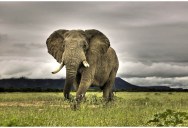15 of the Largest Animals in the World
Our world is full of creatures big and small, short and tall. Below the Sifter looks at 15 of the largest animals in the world, classified by various categories such as mammals, reptiles, birds, amphibians etc. There’s an incredibly detailed list of some of the world’s largest organisms (including plants, fungi, bacteria, etc.) on Wikipedia, check it out if you enjoy lists as much as we do 🙂 For now, enjoy these fifteen fascinating animals.
The Largest Animal Ever: The Blue Whale





The blue whale (Balaenoptera musculus) is a marine mammal belonging to the suborder of baleen whales. At 30 metres (98 ft) in length and 180 metric tons (200 short tons) or more in weight, it is the largest known animal to have ever existed. The Blue Whale’s tongue weighs around 2.7 metric tons (5,952 pounds), about the size of an average Asian Elephant and its heart weighs about 600 kg (1,300 lb) and is the largest known in any animal. Not only is the heart similar size to a mini-cooper car but also comparable in weight.
The Blue Whale is thought to feed almost exclusively on small, shrimp-like creatures called Krill. During the summer feeding season the Blue Whale gorges itself, consuming an astounding 3.6 metric tons (7,900 pounds) or more each day. This means it may eat up to 40 million krill a day with a daily calorie requirement of an adult Blue Whale in the region of 1.5 million. [Source]
The Heaviest Land Animal in the World: The African Bush Elephant

The African Bush Elephant is the largest living terrestrial (land) animal, with males reaching 6 to 7.5 metres (19.7 to 24.6 ft) in length, 3.3 metres (10.8 ft) in height at the shoulder, and weighing 6 t (13,000 lb). Females are much smaller, reaching 5.4 to 6.9 metres (17.7 to 22.6 ft) in length, 2.7 metres (8.9 ft) in height at the shoulder, and weighing 3 t (6,600 lb). The adult African bush elephant generally has no natural predators due to its great size, but the calves (especially the newborn) are vulnerable to lion and crocodile attacks, and (rarely) to leopard and hyena attacks. [Source]
The Tallest Land Animal in the World: The Giraffe

The giraffe (Giraffa camelopardalis) is an African even-toed ungulate mammal and the tallest living terrestrial animal in the world. It stands 5–6 m (16–20 ft) tall and has an average weight of 1,600 kg (3,500 lb) for males and 830 kg (1,800 lb) for females. The giraffe has an extremely elongated neck, which can be over 2 m (6 ft 7 in) in length, accounting for nearly half of the animal’s vertical height. The long neck results from a disproportionate lengthening of the cervical vertebrae, not from the addition of more vertebrae. [Source]
The Largest Carnivora in the World: The Southern Elephant Seal
The Southern elephant seal is the largest carnivore living today. This seals’ size shows extreme sexual dimorphism, possibly the largest of any mammal, with the males typically five to six times heavier than the females. While the females average 400 to 900 kilograms (880 to 2,000 lb) and 2.6 to 3 meters (8.5 to 9.8 ft) long, the bulls average 2,200 to 4,000 kilograms (4,900 to 8,800 lb) and 4.5 to 5.8 meters (15 to 19 ft) long. The record-sized bull, shot in Possession Bay, South Georgia on February 28, 1913, measured 6.85 meters (22.5 ft) long and was estimated to weigh 5,000 kilograms (11,000 lb).
Southern elephant seals dive repeatedly, each time for more than twenty minutes, to hunt their prey—squid and fish— at depths of 400 to 1,000 meters (1,300 to 3,300 ft). The documented diving records for the seals are nearly two hours for the duration, and more than 1,400 meters (4,600 ft) in depth. [Source]
The diverse order Carnivora includes over 280 species of placental mammals. Its members are formally referred to as carnivorans, while the word “carnivore” (often popularly applied to members of this group) can refer to any meat-eating organism. Carnivorans are the most diverse in size of any mammalian order, ranging from the least weasel (Mustela nivalis), at as little as 25 grams (0.88 oz) and 11 centimetres (4.3 in), to the polar bear and southern elephant seal. [Source]
The Largest Land Carnivores in the World: The Polar Bear and Kodiak Bear


The largest living land carnivores are the Polar Bear (Ursus maritimus) and the kodiak bear, a Brown Bear (Ursus arctos) subspecies. Since they have similar body sizes, it is not clear which is definitively larger. In both species, shoulder height has been measured at more than 1.6 m (5.2 ft) and total length at as much as to 3.05 m (10.0 ft). The heaviest polar and brown bear weights recorded were respectively 1,003 kg (2,210 lb) and 1,135 kg (2,500 lb). [Source]
The Largest Reptile in the World: The Saltwater Crocodile

The saltwater crocodile (Crocodylus porosus), is the largest of all living reptiles. It is found in suitable habitats from Northern Australia through Southeast Asia to the eastern coast of India. An adult male saltwater crocodile’s weight is 409 to 1,000 kilograms (900–2,200 lb) and length is normally 4.1 to 5.5 metres (13–18 ft). However, mature males can exceed 6 metres (20 ft) and weigh more than 1,000 kilograms (2,200 lb) and this species is the only extant crocodilian to regularly reach or exceed 4.8 metres (16 ft). The saltwater crocodile is an opportunistic apex predator capable of taking nearly any animal that enters its territory, either in the water or on dry land. [Source]
The Largest Amphibian in the World: The Chinese Giant Salamander


The Chinese giant salamander (Andrias davidianus) is the largest salamander in the world, reaching a length of 180 cm (6 ft), although it rarely – if ever – reaches that size today. Endemic to rocky mountain streams and lakes in China, it is considered critically endangered due to habitat loss, pollution, and over-collecting, as it is considered a delicacy and used in traditional Chinese medicine. [Source]
The Largest Rabbit/Hare in the World: The Flemish Giant


The Flemish Giant is an old breed of domesticated rabbits, originating from the Flemish region. They have been bred as early as the 16th century around the city of Ghent, Belgium. The rabbits can weigh up to 12.7 kg (28 pounds). [Source]
The Largest Bats in the World: The Giant golden-crowned flying fox


The largest bat species is the Giant golden-crowned flying fox (Acerodon jubatus), an endangered fruit bat from the rainforests of the Philippines that is part of the megabat family. The maximum size is believed to approach 1.5 kg (3.3 lb), 55 cm (22 in) long, and the wingspan may be almost 1.8 m (5.9 ft). The Large Flying Fox (Pteropus vampyrus) is smaller in body mass and length, but it has been known to exceed the Golden-crowned species in wingspan. Specimens have been verified to 1.83 m (6.0 ft) and possibly up to 2 m (6.6 ft) in wingspan. [Source]
The Largest Rodent in the World: The Capybara


The largest living rodent is the capybara (Hydrochoerus hydrochaeris), native to most of the tropical and temperate parts of South America east of the Andes, always near water. Full-grown capybaras can reach 1.5 m (4.9 ft) long and 0.9 m (3.0 ft) tall at the shoulder and a maximum weight of 105.4 kg (232 lb). It is a highly social species and can be found in groups as large as 100 individuals, but usually live in groups of 10–20 individuals. [Source]
The Largest Bony Fish in the World: The Ocean Sunfish


Osteichthyes, also called bony fish, are a taxonomic group of fish that have bony, as opposed to cartilaginous, skeletons. The vast majority of fish are osteichthyes, which is an extremely diverse and abundant group consisting of over 29,000 species. It is the largest class of vertebrates in existence today.
The largest living bony fish is the widely distributed ocean sunfish (Mola mola). It resembles a fish head with a tail, and its main body is flattened laterally. The mature ocean sunfish has an average length of 1.8 m (5.9 ft), a fin-to-fin length of 2.5 m (8.2 ft) and an average weight of 1,000 kg (2,200 lb), although individuals up to 3.3 m (10.8 ft) in length 4.2 m (14 ft) across the fins and weighing up to 2,300 kg (5,100 lb) have been observed. [Source]
The Largest Lizard/Snake in the World: The Green Anaconda

The most massive living member of this giant reptilian order is the Green Anaconda (Eunectes murinus) of the neotropical riverways. The maximum verified size is 7.5 m (25 ft) and 250 kg (550 lb), although rumors of larger anacondas persist. The Reticulated Python (Python reticulatus) of Southeast Asia is longer but more slender, and has been reported to measure as much as 9.7 m (32 ft) in length. [Source]
The Largest Bird in the World: The Ostrich

The largest living bird is the ostrich (Struthio camelus), from the plains of Africa and Arabia. A large male ostrich can reach a height of 2.8 m (9.2 ft), weighing over 156 kg (345 lb). Eggs laid by the Ostrich can weigh 1.4 kg (3 lb) and are the largest eggs in the world today. They can also run at maximum speeds of about 97.5 km/h (60.6 mph), making it both the fastest bird on land and the fastest two-legged animal in the world. [Source]
The Heaviest Flying Bird in the World: The Dalmatian Pelican

The Dalmatian Pelican (Pelecanus crispus) is a member of the pelican family. It breeds from southeastern Europe to India and China in swamps and shallow lakes. This is the largest of the pelicans, averaging 160–180 cm (63-70 inches) in length, 11–15 kg (24-33 lbs) in weight and just over 3 m (10 ft) in wingspan. With a mean weight of 11.5 kg (25 lb), it is the world’s heaviest flying bird species on average, although large male bustards and swans can exceed the pelican in maximum weight. [Source]
The Largest Arthropod in the World: The Japanese spider crab


The Japanese spider crab is a species of marine crab that lives in the waters around Japan. It has the largest leg span of any arthropod, reaching up to 3.8 metres (12 ft) and weighing up to 41 pounds (19 kg). In its natural habitat, the Japanese spider crab feeds on shellfish and animal carcasses and may live for up to 100 years. [Source]

Sign up to get our BEST stories of the week straight to your inbox.




